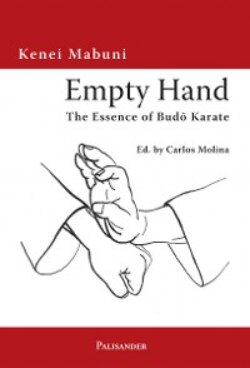Читать книгу Empty Hand - Kenei Mabuni - Страница 22
Karate – the Fundament of Martial Arts
ОглавлениеMy father used to say: “Karate is the legitimate heir of the bujutsu martial arts.”31 I think that karate is in fact the basis of all budō fighting techniques. There are two reasons for this statement. First, fighting with nothing but the empty hands is the most elementary way of fighting. Furthermore it is justified to say that any weapons, from staff, sword, bow and arrow or gun up to present-day missiles, could be regarded as extensions of the hand.
If one does not have any weapons one has no choice but to fight with empty hands. If a samurai was called to fight against an unarmed opponent, he would lay down his weapons without any hesitation. The tournaments in the Heian and Kamakura periods always started with archery and were followed by spear and sword fighting. When the fights became too violent the opponents got the order: “Attention! Depart!” They had to lay down their weapons and to continue fighting with empty hands.
If forced to fight with empty hands, everything within reach can be used as an assisting fighting tool. That is the logical and historical starting point for the development of the various techniques of armed fighting. Jūjutsu is a technical system to support fighting with a sword or other weapons, whereas karate integrates weapons to support fighting with empty hands. On the Ryūkyū Islands, for centuries several agricultural and other tools have been used to support karate fighting such as staffs (bō), tridents (sai), sticks with a side-handle (tonfa) or segmented staffs (nunchaku).32
There is a second reason for considering karate as the fundament of all budō fighting techniques: There are no forbidden techniques because the aim is to injure the opponent deadly and this aim must be reached unarmed, with empty hands. That is why the whole body is extremely well prepared for fighting. During the prohibition of arms under the Satsuma rule, the old knowledge about how to fight for life and death without weapons was transferred from generation to generation quite exactly, although not in a written form. Karate practice consisted mainly of kata practice which was done alone so that nobody could be hurt and therefore no kicks or thrusts or punches had to be forbidden. So karate became a worldwide unique art of fighting.
In 1938 my father wrote in this context the following:
If there are people who think that under the pretext of physical education kata and kumite should be changed into sports and separated from their bujutsu or martial arts essence just to fit into the modern times, they should be told that they are obviously not realizing that by doing so they are making the first step to commit a very serious mistake, that is they are contributing to the destruction of the original values of karate as bujutsu. Of course in the practice of kata and kumite the movements of the arms and the legs must be evaluated in detail. But this must be done from a martial arts point of view. Rational-physiologically based preparing and supporting exercises to improve the function of the limbs and the inner organs can be integrated in the practice of karate. But no one should think that the martial content of kata and kumite practice could be improved by changing both into sports or enjoyment.
In a certain way my father thus predicted the present form of karate and warned us of this development. The transformation of karate into competitive sports is one of the main topics of this book, too. But before coming to this point, I would like to say something more about the history of karate.
